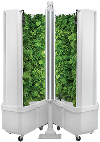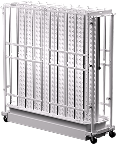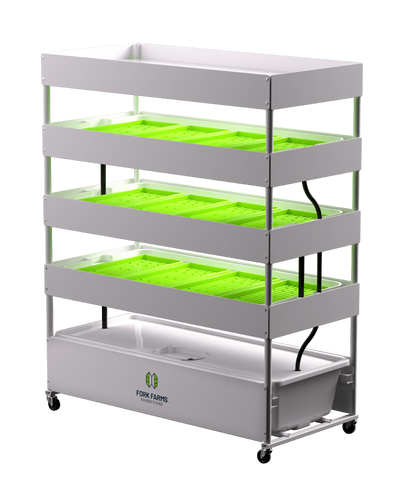The Best Hydroponic Gardens Available Today Should Include:
One of the most important advancements in the production of food is that consumers are becoming more proactive and involved in food systems. As consumers begin to understand where their food comes from, there has become a significant demand for solutions like hydroponic gardens, enabling communities, educators, and home farmers to grow their own herbs, vegetables, and fruit.
What Should The Best Hydroponic Gardens Available Today Include?
When it comes to hydroponics, it can be challenging for new and even experienced gardeners to know where to start. The technique's popularity has led to various hydroponic gardens being sold, each with advantages and disadvantages. In our experience, understanding how hydroponic gardens work is the key to finding the right system.
Whether you’re new to hydroponics or an experienced gardener looking to experiment with a different technique, this article will explain the basics of hydroponic gardening, the benefits, and, ideally, what hydroponic gardens should include.
Understanding Hydroponic Gardening Basics
Hydroponic gardening uses a medium like coconut fibers, rockwool, or clay pellets to submerge plant roots in a nutrient-rich solution with essential minerals in place of soil. The variables with hydroponic gardening are easier to control and take a common challenge (low or poor-quality soil) out of the equation.
There can be many advantages of growing your own food versus shopping at the available stores in your area. Growers can harvest crops at their peak freshness, use less natural resources, and practice year-round growing, which can be a game changer for communities in cold or dry climates.
The benefits of hydroponic gardens also include:
- Growers can maximize space with compact vertical systems
- Improved water efficiency through recirculation and reuse
- Zero food miles required with hydroponic gardening on-site
- Estimated 45 times more food production compared to traditional soil agriculture
- 98 percent less water and land usage
- Control over the growing environment for faster plant growth
The benefits that hydroponic gardening offers are why it’s important to understand the process and choose the right garden for your needs.
Indoor Hydroponic Gardens: Year-Round Growing
Every location has a growing season, whether long, short, or nonexistent. Alaska, for example, has a very short growing season, and on average, only about 105 days. Year-round growing, one of the major advantages of indoor hydroponic gardens, makes it possible to grow plants regardless of weather conditions. Year-round growing in a controlled environment allows for diverse plant options and large quantities of nutritious food, which can be essential for communities with limited access to suppliers of fresh produce. Due to the lack of soil, plants grown through hydroponic gardens are also more likely to be pest and disease-free.
What do the Best Hydroponic Gardens on the Market Include?
There are a lot of different brands of hydroponic gardens out there. While one brand of garden won’t be a fit for every aspiring grower, there are best practices that customers should look for when shopping around.
These include:
- Alignment of growing capacity, maintenance/labor needs with program goals and resources
- Affordable pricing and warranty on product
- All parts and components of the hydroponic garden included
- Easy to assemble and set up
- A simple growing method
- High-quality consumables available for purchase
While not required for the garden to function, having expert growing support from customer service is also extremely helpful. Hydroponic gardening, while not as challenging as it may seem, does have a learning curve. With a trusted customer support team available, you can field any questions and ensure you set up your system correctly. Additional value adds, including learning resources, videos, and a curriculum, can also be useful.
Fork Farms: Vertical Hydroponic Farm Innovation
Fork Farms has a lot of hydroponic farming experience, offering the most efficient, scalable, and transformative hydroponic technology on the planet. Our end-to-end support from the Fork Farms team of hydroponics experts is an example of the type of customer service you can get from a hydroponics company. Understanding the importance of collaboration and connection between growers, we also offer our customers access to the Farmative community, where you can meet like-minded, innovative growers.
The Flex Farm Advantage
Our Flex Farm can help you reach the highest potential for hydroponic gardening, yielding more crops with less water and space. With 288 plant spaces and the opportunity for 25+ lbs of leafy greens per month, our ‘farm in a box’ is a great option to start hydroponic farming. Our system makes it as easy as possible to learn the ropes, as Flex Farm only requires about two hours of regular maintenance per month.
Explore the Possibilities of Hydroponics with Fork Farms
Hydroponic gardening has a lot of benefits, and with the right hydroponic garden, growers can quickly customize their process and scale their growth. As the outcome of your efforts can be contingent on the system you select, informed decision-making and careful consideration are vital to ensure you choose the best hydroponic garden. Our Flex Farm hydroponic garden system aligns with many needs, and we consider it a top choice for educators, food service providers, farmers, or individuals looking to bring hydroponics to their communities.
Ready to get started with Fork Farms? Reach out to us today!
Important Links:
























